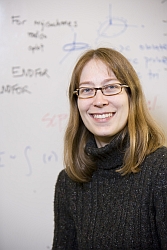Haverford Professor Receives Major National Science Foundation Support

Details
Beth Willman's search for the least luminous galaxies in the universe will get a big assist thanks to funding from the National Science Foundation, which awarded the Haverford professor $422, 000. Willman, a leading researcher in ultra-faint galaxies who joined the Haverford faculty last year, will use the funding to support her efforts to find nearly-invisible galaxies that orbit the Milky Way and to create computer simulations of the formation of the Milky Way. Working with Willman on her research are Haverford students Gail Gutowski, Dylan Hatt, Alex Warres, Jennifer Campbell, Andrew Sturner and Kathryn Meehan.
Willman is also part of a team of scientists who have been using the velocities of the stars in nearby dwarf galaxies to measure their masses. Last year, the team published a paper in Astrophysical Journal on the dwarf Segue 1. Their conclusion: It may be the most dark-matter dominated galaxy yet found.
Willman, who holds a Ph.D. in astronomy from the University of Washington, has been a James Arthur Fellow at the Center for Cosmology and Particle Physics, and a Clay Fellow at the Harvard-Smithsonian Center for Astrophysics. A pioneer in near-field cosmology, one of the ultra-faint dwarf galaxies she identified in 2005 is named for her: Willman 1.
Willman is also involved in the planning for the Large Synoptic Survey Telescope (LSST), a project that will combine the largest digital camera ever built (3200 megapixels) with an 8.4m telescope to image faint objects across the sky. In an article about her published this month by the LSST Project in an E-newsletter, Willman talked about the joys of her work: “The satisfaction of seeing astronomical objects that no one has ever seen before is incredible—both exciting and deeply moving,” she said.



